欧盟社会政策【英文】
《欧洲联盟运行条件》114条适用条件

《欧洲联盟运行条件》114条适用条件概述欧洲联盟(E ur op ean U ni on,简称E U)是由28个成员国组成的政治经济联盟。
为了确保联盟的顺利运行,欧盟设立了一系列的运行条件。
本文将介绍《欧洲联盟运行条件》中的114条适用条件,旨在帮助读者更好地了解欧盟的工作原则和运行机制。
第一章宪法框架与基本法律1.第一部分:欧洲联盟宪法的制定和修改2.第二部分:欧盟基本法律的法律地位-2.1欧盟基本法律的构成要素-2.2欧盟基本法律的修正程序-2.3欧盟基本法律的适用和效力第二章政治机构与决策机制1.欧洲理事会的角色和职能2.欧洲理事会主席的选举和任期3.欧洲委员会的组成和职责4.欧洲议会的议员选举制度5.欧洲议会的议事规则和决策程序6.欧盟法院的司法管辖权和法官任命第三章经济政策与市场规则1.欧洲联盟的共同市场原则-1.1欧盟成员国的商品自由流通-1.2欧盟成员国的劳动力自由流动-1.3欧盟成员国的资本自由流动2.欧盟的经济政策协调机制-2.1欧盟成员国的财政政策协调-2.2欧盟成员国的货币政策协调-2.3欧盟成员国的经济结构政策协调3.欧盟的竞争政策和反垄断规定4.欧盟与非成员国的贸易关系第四章社会政策与人权保障1.欧盟的劳动力和社会保护政策-1.1欧洲劳工权益保护法-1.2欧洲社会福利制度2.欧盟的环境保护政策-2.1欧盟对气候变化的应对措施-2.2欧盟对环境污染的防治措施3.欧盟成员国的公民权利和人权保护-3.1欧洲人权公约的适用范围-3.2欧盟成员国公民的自由权利保护第五章外交与安全政策1.欧盟的共同外交与安全政策原则2.欧盟与成员国之间的外交协调机制3.欧盟对外援助政策和国际合作机制4.欧盟的联合国事务和国际安全事务参与5.欧盟对非洲、亚洲和拉美国家的政策第六章适用条件的执行和违约责任1.欧盟成员国对欧盟法规的执行2.欧盟成员国的违约责任和处罚机制3.欧盟委员会的违约调查和裁决程序结论本文对《欧洲联盟运行条件》中的114条适用条件进行了详细介绍,涵盖了欧盟的宪法框架与基本法律、政治机构与决策机制、经济政策与市场规则、社会政策与人权保障、外交与安全政策以及适用条件的执行和违约责任等方面。
欧盟的社会保障与福利制度

欧盟的社会保障与福利制度欧盟(European Union,简称EU)作为一个由28个成员国组成的经济和政治联盟,致力于保障其公民的社会保障与福利。
欧盟的社会保障与福利制度旨在提供对公民的基本需求的保障,包括医疗保险、养老金、失业救济等。
本文将介绍欧盟社会保障与福利制度的主要特点和运作机制。
一、医疗保险制度欧盟的医疗保险制度建立在公民的普惠基础上,旨在确保所有公民获得基本医疗保障。
每个成员国都有自己的国家医疗保险系统,但基本原则是相似的。
公民通过支付社会保险费用来参与医疗保险计划,以便在需要医疗服务时能够享受到相应的待遇。
欧盟通过合作与协调机制确保医疗保险制度在成员国之间的互通和协调性。
二、养老金制度欧盟的养老金制度旨在确保公民在退休后能够维持基本的生活水平。
不同成员国的养老金制度存在差异,但都遵循一定的原则和标准。
公民通过支付社会保险费用来积累养老金,并在达到退休年龄后开始领取。
欧盟通过共同努力,致力于确保养老金制度的可持续性和公正性。
三、失业救济制度欧盟的失业救济制度旨在帮助失业公民渡过经济困难时期,并提供重新就业的支持。
失业公民根据不同成员国的规定,可以领取一定期限的失业救济金,同时接受相关的培训和职业指导,以便更快地重新就业。
欧盟致力于促进跨国劳动力流动和促进就业机会的增加,以提高失业救济制度的效果和公平性。
四、家庭福利制度欧盟注重对家庭的支持和保障,通过一系列措施来提供家庭福利。
这些措施包括育儿津贴、有偿育儿假、灵活工作时间等,旨在帮助家庭平衡工作与家庭生活的需求。
欧盟鼓励成员国实施家庭友好政策,以提高家庭福利制度的覆盖率和效果。
总结欧盟的社会保障与福利制度在保障公民基本需求、促进社会公平和经济可持续发展方面发挥了重要作用。
通过协调和合作机制,欧盟确保成员国之间的制度互通和衔接,提高公民在欧盟范围内的社会保障和福利待遇。
然而,不同成员国的制度差异和社会经济发展水平的不平衡,仍然是进一步完善和统一欧盟社会保障与福利制度的挑战,需要各成员国共同努力。
澳门大学欧洲事务授课型研究生申请要求
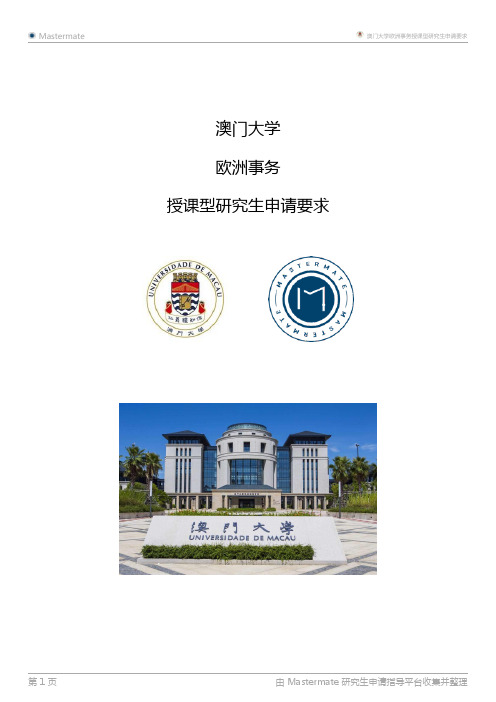
澳门大学欧洲事务授课型研究生申请要求澳门大学简介学校名称澳门大学学校英文名称University of Macau学校位置中国 | 澳门 | 氹仔2020 QS 世界排名387澳门大学概述澳门大学(Universidade de Macau / University ofMacau),简称澳大,是澳门第一所现代大学,为中欧商校联盟、“一带一路”国际科学组织联盟创始成员,是澳门第一所获AACSB认证的大学。
澳门大学前身为1981年3月28日成立的东亚大学。
1991年更名为澳门大学。
2014年8月正式迁入位于横琴岛的新校区。
据2019年8月学校官网显示,学校校园面积约一平方公里;设有10个学院,约130多个学位课程;拥有学生10,414人,其中本科生7141人,研究生3,273人;截至2018年12月,澳门大学全职工作人员总数1538人。
欧洲事务专业简介欧洲事务欧洲事务专业相关信息专业名称欧洲事务专业英文名称Master of Arts in European Studies隶属学院社会科学院学制2年语言要求雅思6(小分5.5),托福80,六级430GMAT/GRE 要求不需要2020 Fall 申请时间10月学费(当地货币)102600澳门币欧洲事务课程内容序号课程中文名称课程英文名称1公共政策与政治Public Policy and Politics2政府与欧盟治理Governments and EU Governance 3社会政策与欧洲认同Social Policy and European Identity 4欧洲一体化的历史History of European Integration5研究方法Research Methods6学术写作Academic Writing7宏观经济学导论Introduction to Macroeconomics 8欧洲一体化理论Theory of European Integration9欧盟经济政策Economic Policies of the EU10欧洲货币联盟The European Monetary Union in the World11全球化与欧盟的外国直接投资Globalization & EU’s Foreign Direct Investment12欧盟与可持续发展EU and Sustainable13欧洲经济精选话题Selected Topics in European Economy14欧盟第一法-机构与条约EU Law I - Institutions and Treaties 15欧盟第二法-四项自由EU Law II - Four Freedoms16里斯本条约与制度改革弗朗西斯The Lisbon Treaty and Institutional Reform Francis17国际关系理论Theory of International Relations 18欧盟的对外与安全政策External & Security Policies of EU19欧盟与世界I:邻里EU and the World I: the Neighbourhood序号课程中文名称课程英文名称20欧盟与第二世界:欧盟与亚洲的关系EU and the World II: EU-Asia Relations21欧盟与世界III:世界其他地区EU and the World III: the Rest of the World* 澳门大学欧洲事务研究生申请要求由 Mastermate 收集并整理,如果发现疏漏,请以学校官网为准。
欧盟的人权保护与社会正义

欧盟的人权保护与社会正义欧盟作为一个政治经济实体,其人权保护与社会正义一直是其重要的发展目标。
本文将从欧盟的人权法框架、人权保护机制以及社会正义政策三个方面探讨欧盟在这一领域的努力和成就。
一、欧盟的人权法框架欧洲联盟成立的宗旨之一就是确保欧洲所有成员国和公民享有基本的人权和自由。
欧盟的人权法框架主要包括欧洲联盟基本权利宪章和欧洲人权公约。
欧洲联盟基本权利宪章于2000年通过,是欧洲联盟的第一个具有约束力的人权文件,其中囊括了包括言论自由、信仰自由、平等权利等在内的一系列基本权利。
欧洲人权公约则是欧洲人权法的核心文件,对个人权利的保护作出了具体规定。
二、欧盟的人权保护机制为了保障人权的实施和监督,欧盟建立了一套完整的人权保护机制。
其中,欧洲联盟法院、欧洲人权法院以及欧洲委员会扮演了重要的角色。
欧洲联盟法院是欧洲联盟内最高级别的司法机构,负责确保欧盟法律和其他成员国之间的法律保持一致,并保障联盟的法律准则得到遵守。
欧洲人权法院则是负责处理侵犯欧洲人权公约的申诉和决定。
而欧洲委员会则是负责监督欧洲公民权利的实施情况,同时也是一种信访机构。
三、欧盟的社会正义政策欧盟致力于通过社会正义政策来保护弱势群体的权益,促进社会公平和包容。
这一政策主要体现在教育、就业和福利三个方面。
在教育领域,欧盟通过投资教育资源来促进社会平等。
欧盟通过资助教育项目、提供奖学金等方式,鼓励各成员国提供平等的机会,确保所有人都享有受教育的权利。
在就业领域,欧盟致力于消除就业歧视,保护劳动者的权益。
欧盟通过立法措施和政策引导,推动雇主提供平等的就业机会,保障劳动者的福利和待遇。
在福利领域,欧盟倡导建立社会安全网络,保障每个人的权益。
欧盟通过设立最低工资标准、提供社会保障制度等措施,确保每个成员国公民都能享受基本的福利保障。
总结:欧盟在人权保护与社会正义方面积极努力,通过制定法律框架、建立人权保护机制以及推行社会正义政策,致力于保障每个人的基本权利和福祉。
欧盟的决策机制与决策过程

欧盟的决策机制与决策过程欧洲联盟(European Union,EU)是由欧洲国家自愿组成的政治和经济联盟。
作为一个多国家体系,欧盟的决策机制与决策过程非常独特而复杂。
本文将探讨欧盟的决策机制以及相关的决策过程。
一、决策机制欧盟的决策机制旨在确保成员国在决策过程中享有平等地位,同时保障欧盟整体的利益。
以下是欧盟常用的决策机制:1. 普通立法程序:普通立法程序是欧盟最常用的决策机制。
在该机制下,欧盟委员会(European Commission)提出法案,然后提交给欧洲议会(European Parliament)和欧洲理事会(Council of the European Union)进行讨论和修改。
最终,经过两个机构的协商和投票决定,法案可以成为正式的欧盟法律。
2. 共同决策程序:共同决策程序(Co-decision)是一种需要欧洲议会和欧洲理事会共同参与决策的机制。
在这个程序中,欧盟委员会提出法案,然后欧洲议会和欧洲理事会进行协商和修改。
最终,两个机构需要达成共识才能通过法案。
3. 合作程序:合作程序是一种针对特定领域的决策机制。
在该程序下,欧洲议会和欧洲理事会共同参与决策,但欧洲委员会的发言权较少。
这种机制用于欧盟内部政策的制定,如社会政策、环境政策等。
4. 一致性程序:一致性程序适用于某些敏感领域,如外交政策和税收政策。
在该机制下,所有成员国必须就决策达成一致意见,否则决策无法通过。
二、决策过程欧盟的决策过程需要考虑多个利益相关方的意见和权益。
以下是欧盟决策过程的一般步骤:1. 提案阶段:决策的提案通常由欧洲委员会发起。
委员会会制定相关的法案,并在必要时进行咨询和听证会等程序,以收集各方的意见和建议。
2. 讨论和修改阶段:法案一旦提出,就会交给欧洲议会和欧洲理事会进行讨论和修改。
这两个机构会通过委员会、专门委员会或工作组等形式,根据各自的权益和意见对法案进行修改。
3. 协商阶段:在讨论和修改的基础上,欧洲议会和欧洲理事会需要进行协商以达成共识。
欧盟及其成员国

欧洲联盟(European Union),简称欧盟(EU),是由欧洲共同体(European Communities,又称欧洲共同市场) 发展而来的,是一个集政治实体和经济实体于一身、在世界上具有重要影响的区域一体化组织。
1991年12月,欧洲共同体马斯特里赫特首脑会议通过《欧洲联盟条约》,通称《马斯特里赫特条约》(简称《马约》)。
1993年11月1日,《马约》正式生效,欧盟正式诞生。
欧盟现有27个成员国和近5亿人口(2007年1月),总部设在比利时首都布鲁塞尔。
欧盟的宗旨是“通过建立无内部边界的空间,加强经济、社会的协调发展和建立最终实行统一货币的经济货币联盟,促进成员国经济和社会的均衡发展”,“通过实行共同外交和安全政策,在国际舞台上弘扬联盟的个性”。
【成立过程】欧洲统一思潮存在已久,在第二次世界大战后进入高潮。
1946年9月,英国首相丘吉尔曾提议建立“欧洲合众国”。
1950年5月9日,法国外长罗伯特·舒曼提出欧洲煤钢共同体计划(即舒曼计划),旨在约束德国。
1951年4月18日,法、意、联邦德国、荷、比、卢六国签订了为期50年的《关于建立欧洲煤钢共同体的条约》。
1955年6月1日,参加欧洲煤钢共同体的六国外长在意大利墨西拿举行会议,建议将煤钢共同体的原则推广到其他经济领域,并建立共同市场。
1957年3月25日,6国外长在罗马签订了建立欧洲经济共同体与欧洲原子能共同体的两个条约,即《罗马条约》,于1958年1月1日生效。
1965年4月8日,6国签订了《布鲁塞尔条约》,决定将欧洲煤钢共同体、欧洲原子能共同体和欧洲经济共同体统一起来,统称欧洲共同体。
条约于1967年7月1日生效。
欧共体总部设在比利时布鲁塞尔。
1991年12月11日,欧共体马斯特里赫特首脑会议通过了建立“欧洲经济货币联盟”和“欧洲政治联盟”的《欧洲联盟条约》(通称马斯特里赫特条约,简称“马约”)。
1992年2月1日,各国外长正式签署马约。
PEST分析【范本模板】

PEST分析PEST分析是指宏观环境的分析,P是政治(politics),E是经济(economic),S是社会(society),T是技术(technology).在分析一个企业集团所处的背景的时候,通常是通过这四个因素来进行分析企业集团所面临的状况。
一.政治环境政治环境主要包括政治制度与体制,政局,政府的态度等;法律环境主要包括政府制定的法律、法规.1。
政治环境是否稳定?2。
政府所持的市场道德标准是什么?3.政府的经济政策是什么?4。
政府是否关注文化与宗教?5.政府是否与其他组织签订过贸易协定,例如欧盟(EU),北美自由贸易区(NAFTA),东盟(ASEAN)等?6.国家政策是否会改变法律从而增强对企业的监管并收取更多的赋税?二.经济环境构成经济环境的关键战略要素:GDP、利率水平、财政货币政策、通货膨胀、失业率水平、居民可支配收入水平、汇率、能源供给成本、市场机制、市场需求等.1。
利率。
2。
通货膨胀率与人均就业率。
3.人均GDP的长远预期等。
三.社会环境影响最大的是人口环境和文化背景。
人口环境主要包括人口规模、年龄结构、人口分布、种族结构以及收入分布等因素。
1. 信奉人数最多的宗教是什么?2。
这个国家的人对于外国产品和服务的态度如何?3. 语言障碍是否会影响产品的市场推广?4. 这个国家的男人和女人的角色分别是什么?5。
这个国家的人长寿吗?老年阶层富裕吗?6. 这个国家的人对于环保问题是如何看待的?四.技术环境技术环境不仅包括发明,而且还包括与企业市场有关的新技术、新工艺、新材料的出现和发展趋势以及应用背景。
1. 科技是否降低了产品和服务的成本,并提高了质量?2. 科技是否为消费者和企业提供了更多的创新产品与服务,例如网上银行、新一代手机等?3。
科技是如何改变分销渠道的,例如网络书店、机票、拍卖等?4。
科技是否为企业提供了一种全新的与消费者进行沟通的渠道,例如Banner广告条、CRM软件等?五.影响因素PEST分析法是战略外部环境分析的基本工具,它通过政治的(Politics)、经济的(Economic)、社会的(Society)和技术的(Technology)角度或四个方面的因素分析从总体上把握宏观环境,并评价这些因素对企业战略目标和战略制定的影响。
欧盟变更的分类
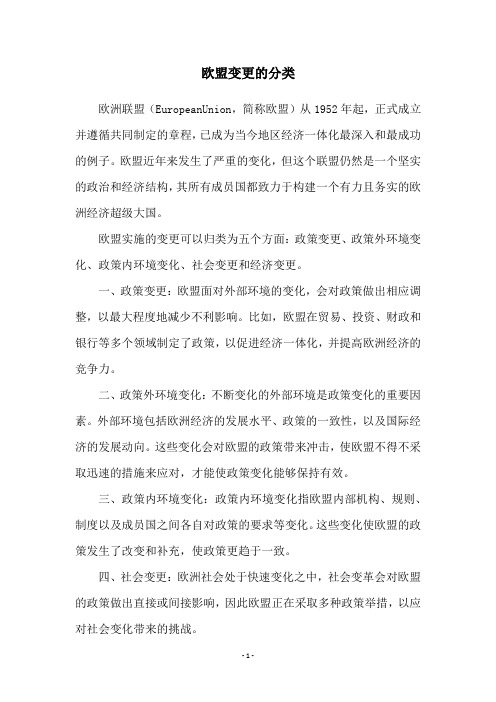
欧盟变更的分类欧洲联盟(EuropeanUnion,简称欧盟)从1952年起,正式成立并遵循共同制定的章程,已成为当今地区经济一体化最深入和最成功的例子。
欧盟近年来发生了严重的变化,但这个联盟仍然是一个坚实的政治和经济结构,其所有成员国都致力于构建一个有力且务实的欧洲经济超级大国。
欧盟实施的变更可以归类为五个方面:政策变更、政策外环境变化、政策内环境变化、社会变更和经济变更。
一、政策变更:欧盟面对外部环境的变化,会对政策做出相应调整,以最大程度地减少不利影响。
比如,欧盟在贸易、投资、财政和银行等多个领域制定了政策,以促进经济一体化,并提高欧洲经济的竞争力。
二、政策外环境变化:不断变化的外部环境是政策变化的重要因素。
外部环境包括欧洲经济的发展水平、政策的一致性,以及国际经济的发展动向。
这些变化会对欧盟的政策带来冲击,使欧盟不得不采取迅速的措施来应对,才能使政策变化能够保持有效。
三、政策内环境变化:政策内环境变化指欧盟内部机构、规则、制度以及成员国之间各自对政策的要求等变化。
这些变化使欧盟的政策发生了改变和补充,使政策更趋于一致。
四、社会变更:欧洲社会处于快速变化之中,社会变革会对欧盟的政策做出直接或间接影响,因此欧盟正在采取多种政策举措,以应对社会变化带来的挑战。
五、经济变更:欧洲经济在过去几年经历了快速发展,其中一个重要因素是欧盟促进经济一体化和加强各国经济联系的政策。
欧盟通过制定和实施适应这种变化的政策,帮助欧洲经济走向发展,以实现宏观的经济效益。
从上述概述来看,欧盟变更的分类主要是政策变更、政策外环境变化、政策内环境变化、社会变更和经济变更。
欧盟的政策变更可以满足其目标,即促进经济一体化,实现有效的欧洲经济发展、改善涉及欧洲社会利益和保护欧洲共同利益。
欧盟领导人更加侧重于实施经济集成,并积极推进欧洲经济联盟的发展,以实现对欧洲经济更大规模的整合。
欧盟已经发展成为当今世界最大的地区经济一体化体系,政策变更是欧盟实现经济一体化最关键的因素。
欧洲联盟名词解释
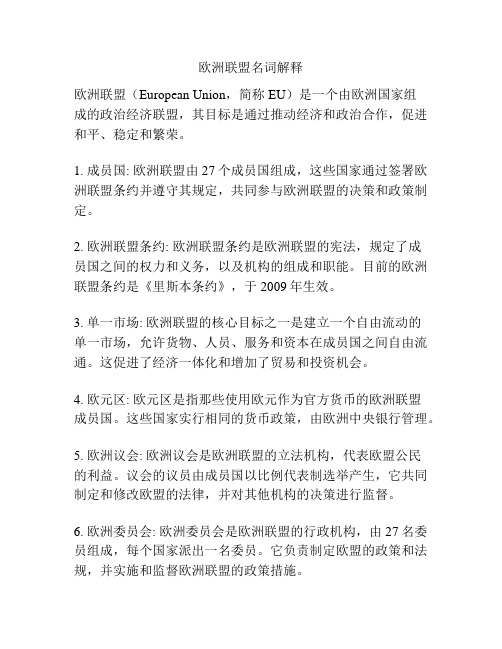
欧洲联盟名词解释欧洲联盟(European Union,简称EU)是一个由欧洲国家组成的政治经济联盟,其目标是通过推动经济和政治合作,促进和平、稳定和繁荣。
1. 成员国: 欧洲联盟由27个成员国组成,这些国家通过签署欧洲联盟条约并遵守其规定,共同参与欧洲联盟的决策和政策制定。
2. 欧洲联盟条约: 欧洲联盟条约是欧洲联盟的宪法,规定了成员国之间的权力和义务,以及机构的组成和职能。
目前的欧洲联盟条约是《里斯本条约》,于2009年生效。
3. 单一市场: 欧洲联盟的核心目标之一是建立一个自由流动的单一市场,允许货物、人员、服务和资本在成员国之间自由流通。
这促进了经济一体化和增加了贸易和投资机会。
4. 欧元区: 欧元区是指那些使用欧元作为官方货币的欧洲联盟成员国。
这些国家实行相同的货币政策,由欧洲中央银行管理。
5. 欧洲议会: 欧洲议会是欧洲联盟的立法机构,代表欧盟公民的利益。
议会的议员由成员国以比例代表制选举产生,它共同制定和修改欧盟的法律,并对其他机构的决策进行监督。
6. 欧洲委员会: 欧洲委员会是欧洲联盟的行政机构,由27名委员组成,每个国家派出一名委员。
它负责制定欧盟的政策和法规,并实施和监督欧洲联盟的政策措施。
7. 欧洲理事会: 欧洲理事会是由每个成员国的国家元首或政府首脑组成的机构。
它提供欧盟的政治指导并制定战略性的指导方针。
欧洲理事会还负责处理与成员国之间的关系和促进欧盟内的合作。
8. 《里斯本战略》: 《里斯本战略》是欧盟在2000年采取的一项宏伟计划,旨在通过增加欧盟的经济竞争力和创新力,加强社会和环境可持续发展,以及提高就业和社会包容性。
9. 瑞典例外权: 瑞典例外权是指瑞典在加入欧盟时获得的特殊权力,允许其在某些特定领域保留国家主权,而不参与相关的欧盟政策制定和法定规定。
10. 整体性政策: 整体性政策是欧盟的一个特点,其涉及各个领域的政策相互联系和协调。
通过整体性政策,欧盟的目标是在各个政策领域中实现协同效应,以达到更好的结果和效益。
欧盟社会政策

《社会政策议程》提出欧盟必须致力于提高社会政策的质量,这体现为以下几个方面的目标:(1)改进社会保护并使其现代化,以回应知识经济的转型、社会结构和家庭结构的变迁,并增强社会保护作为一种生产要素的作用。
具体政策包括:调整社会保护体制,使劳动者不吃亏(make work pay),提供稳定的收人,降低养老金的风险并使养老金体制可持续,确保医疗照顾的质量和可持续性。
(2)促进社会融人。
其目标是,防止和消除贫困与社会排斥,使所有社会成员融人到经济生活和社会生活之中。
政策重点是加强教育和培训,为包括残疾人、少数民族和新移民在内的弱势群体提供更多更好的就业机会。
(3)促进性别平等。
欧盟认为,男女平等不仅是权利问题,而且是促进社会进步和经济发展的重要组成部分。
性别平等的目标是,促进妇女在经济、科学、社会、政治生活中的全面参与。
重点是解决针对妇女的暴力问题,而在就业方面,则要求实现男女同酬、消除劳动力市场中的性别隔离、协调家庭和工作之间的关系等。
(4)强化基本权利、反对歧视。
其目标是,确保基本社会权利的发展以及对基本社会权利的尊重,在雇佣关系中保护个人隐私。
具体措施包括:在雇佣关系中禁止源由种族、宗教或信仰、年龄或性倾向的歧视;反对种族主义和仇外;消除对残疾人的歧视。
另外,对于那些合法居住在欧盟的第三国公民,特别是长期居住者,应实行同等待遇原则,以便使他们融人到东道国的社会之中。
欧盟社会政策的历史发展自1957年签订罗马条约后的40余年历史中,欧盟社会政策的发展经历了许多变化,大体上我们可以将其划分为四个阶段。
总的来讲,欧盟社会政策的发展是从小到大、从弱到强、从零敲碎打到逐步系统化、制度化。
第一阶段:萌芽和产生阶段(1957-1985)当1957年在“欧洲煤钢联合体”的基础上,欧洲经济共同体(EEC)成立时,主要的动机是市场利益,如同其名称一样,它首先是一个“经济”共同体。
发起国在签订“罗马条约”时,都相信,如果企业能在平等的条件下竞争,资源分配将会更有效,由此推动的经济增长将会自动导致社会发展。
欧共体知识点总结

欧共体知识点总结
欧洲共同体(European Community,EC)是欧洲共同体法律规范的一个固有部分,它是
欧盟最早形成的一部分,是欧盟的经济和社会政策的基础。
欧洲共同体包括三个基本组件:欧洲煤钢共同体(European Coal and Steel Community,ECSC)、欧洲经济共同体(European Economic Community,EEC,也被称为“共同市场”)和欧洲原子能共同体(European Atomic Energy Community,EURATOM)。
这三个共同体是1957年《罗马条约》的规定,随着建立“欧洲单一市场”的行动计划(1992年)、《马斯特里赫特条约》
的签署(1992年)和《阿姆斯特丹条约》的规定(1997年)等多项措施被逐渐取代并继承。
欧洲煤钢共同体
欧洲煤钢共同体(European Coal and Steel Community,ECSC),是由比利时、德国、法国、意大利、卢森堡和荷兰等六个国家于1951年签署了《巴黎条约》而成立的。
它对煤
炭和钢铁产品的生产、工业和贸易进行联合控制,是欧洲共同体的起源。
ECSC于2002
年7月23日解散,随之成为欧盟的一部分。
欧洲经济共同体
欧洲经济共同体(European Economic Community,EEC)于1957年由《罗马条约》……(此段文字较长,被截断)
以上是欧共体知识的梗概,具体的知识点不在此一一累述。
欧洲联盟政策与发展分析

欧洲联盟政策与发展分析欧洲联盟(European Union,简称EU)是由欧洲国家组成的政治经济联盟,旨在促进成员国之间的经济一体化、政治合作和社会发展。
自1957年成立以来,欧盟已经发展成为世界上最具影响力的超国家组织之一。
本文将对欧盟的政策和发展进行分析,并展望未来的发展趋势。
一、欧盟政策1.经济政策:欧盟的经济政策旨在建立一个统一的市场,促进成员国之间的贸易和投资自由化。
欧盟通过多个机构和政策工具来推动经济一体化,例如欧洲中央银行负责欧元区货币政策,欧洲委员会负责制定和实施公共财政和经济政策。
2.农业政策:欧盟的农业政策旨在保障农民的利益和食品安全。
欧盟通过补贴农业生产、设定进口关税和监督农业贸易来实现上述目标。
然而,农业政策也面临一些挑战,如资源利用效率低、环境影响和贸易争端等问题。
3.环境政策:欧盟对环境保护十分重视,致力于减少碳排放、提高能源效率、保护生物多样性等。
欧盟通过设立环境标准、推动可持续发展等措施来实现环境保护目标。
然而,在某些领域,如空气和水污染,欧盟仍面临挑战。
4.移民和庇护政策:移民和庇护政策是欧盟内部的热点问题。
欧盟致力于建立一个公平和有效的移民和庇护制度,提供保护和支持给寻求庇护的人群。
然而,由于成员国之间存在意见分歧和压力差异,移民和庇护政策仍然面临一些挑战。
二、欧盟的发展1.成员国扩展:自成立以来,欧盟已经扩展到27个成员国,并逐渐向东欧国家扩展。
新成员国的加入为欧盟带来了更大的经济市场和政治影响力,同时也带来了一些挑战,如文化差异和经济发展不平衡。
2.货币一体化:欧元是欧盟的共同货币,自1999年开始在成员国中使用。
欧元区的货币一体化为成员国之间的贸易和投资提供了便利,也增加了欧盟的经济一体化程度。
然而,欧元区也面临着经济政策协调和债务危机等挑战。
3.政治合作加强:欧盟在政治上的合作加强有利于形成共同的外交政策和决策机制。
通过共同行动,欧盟成员国能够在国际事务中发挥更大的影响力,并处理共同面临的挑战,如气候变化、恐怖主义等。
介绍欧盟英文作文带翻译
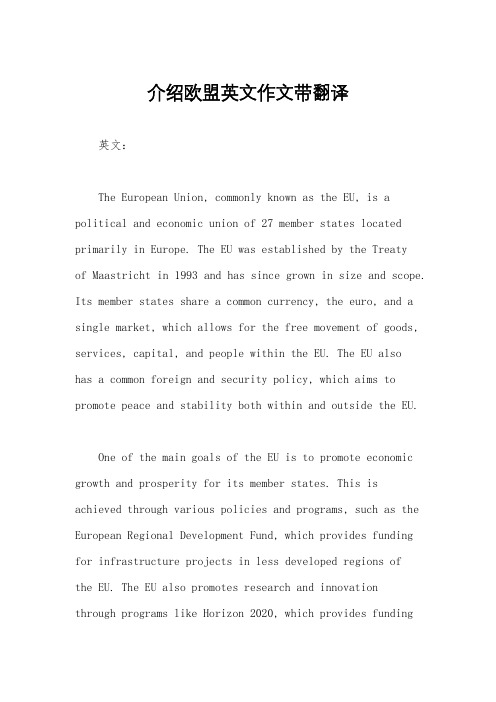
介绍欧盟英文作文带翻译英文:The European Union, commonly known as the EU, is a political and economic union of 27 member states located primarily in Europe. The EU was established by the Treatyof Maastricht in 1993 and has since grown in size and scope. Its member states share a common currency, the euro, and a single market, which allows for the free movement of goods, services, capital, and people within the EU. The EU alsohas a common foreign and security policy, which aims to promote peace and stability both within and outside the EU.One of the main goals of the EU is to promote economic growth and prosperity for its member states. This is achieved through various policies and programs, such as the European Regional Development Fund, which provides funding for infrastructure projects in less developed regions ofthe EU. The EU also promotes research and innovationthrough programs like Horizon 2020, which provides fundingfor research projects in areas such as health, energy, and the environment.In addition to its economic goals, the EU also aims to promote social justice and human rights. For example, the EU has established the European Social Fund, which provides funding for projects that aim to reduce poverty and promote social inclusion. The EU also has a Charter of Fundamental Rights, which outlines the basic rights and freedoms that all EU citizens are entitled to.Overall, the EU plays a crucial role in promoting cooperation and unity among its member states. By working together, the EU is able to tackle common challenges and achieve common goals, such as promoting economic growth, protecting human rights, and maintaining peace and stability.中文:欧洲联盟,通常称为欧盟,是由27个成员国组成的政治和经济联盟,主要位于欧洲。
欧盟的社会平等与包容政策

欧盟的社会平等与包容政策欧洲联盟(European Union,简称EU)一直以来致力于促进社会平等和包容。
作为一个由28个成员国组成的政治和经济联盟,欧盟致力于打破社会壁垒,推动公正和包容的社会进步。
本文将从几个方面探讨欧盟的社会平等与包容政策,包括性别平等、残障人士权利以及少数族裔群体的保护等。
一、性别平等欧盟一直以来都致力于性别平等的推进。
在欧盟成立之初,男女平等原则就已经被确立为欧盟的基本价值观。
欧盟通过制定法律和政策来保护妇女的权益,消除性别歧视。
例如,欧盟颁布了《平等报酬指令》,要求雇主给予男女员工同等的薪酬。
此外,欧盟还鼓励各成员国采取措施,提高女性在政治和经济领域的参与度。
通过这些努力,欧盟取得了一定的成就,但仍然需要进一步努力,以实现性别平等的目标。
二、残障人士权利欧盟对促进残障人士的权利保护同样非常重视。
欧盟制定了《残疾人权利公约》,要求成员国在各个领域为残疾人士提供平等的机会和权利。
欧盟成员国需要确保残疾人士享有教育、就业、医疗等方面的平等权益。
此外,欧盟还倡导社会环境的无障碍化,为残障人士提供更好的生活条件。
欧盟的残障人士政策得到了积极回应和实施,但在具体实施过程中仍然面临一些挑战,尤其是社会观念的改变和资源分配的平衡。
三、少数族裔群体的保护欧盟坚信少数族裔群体的权利同样应得到保护和尊重。
欧盟推动成员国采取措施,防止和打击对少数族裔的歧视和仇视犯罪行为,并加强对少数族裔的社会融入和公民权益的保障。
欧盟通过立法和政策支持,鼓励成员国促进多元文化共存和平等待遇。
此外,欧盟还倡导教育系统普及多元文化教育,以提高社会的包容性和多样性。
然而,面对当前欧洲社会中增加的种族偏见和仇恨犯罪,欧盟还有很多工作要做,以确保少数族裔群体的权利得到充分保障。
总结欧盟致力于促进社会平等与包容,通过制定法律和政策来保护不同群体的权益。
本文从性别平等、残障人士权利以及少数族裔群体的保护等几个方面论述了欧盟的政策和努力。
欧盟非政府组织政策的主要内容和特点

欧盟非政府组织政策的主要内容和特点李尔平【摘要】The NGOs are one of strengthen the cooperation between dialogue, to establish the appropriate the main forces involved in the EU governance, since the late 20th century, EU and NGOs has been repeatedly stressed in EU papers. To take civic institutions, to give financial support, are the main implementation tools of put NGO policies in effect. EU's NGO policies have such characteristics as emphasis on openness and transparency, long pending legality, lack of coherence and so on, which is persistence to the reality of lags behind in EU' s social integration.%非政府组织是参与欧盟治理的力量之一。
从20世纪末开始,欧盟文件多次强调要加强与非政府组织的合作并以开展公民对话、建立相应机构、给予资金支持作为落实非政府组织政策的主要工具。
欧盟非政府组织政策具有注重开放性、透明度、久而未决合法性、缺乏连贯性等特征,这些特征的存在与欧洲社会一体化滞后的现实是一致的。
【期刊名称】《学会》【年(卷),期】2012(000)008【总页数】6页(P18-23)【关键词】欧盟;非政府组织政策;社会一体化【作者】李尔平【作者单位】广西师范学院,广西南宁530001【正文语种】中文【中图分类】F279.243近年来,欧盟日益重视非政府组织①的发展,这主要是因为随着欧盟超国家权力的不断加强,欧盟决策体系中缺乏民主和透明度的问题更加突出,由此带来的合法性质疑困扰着欧盟的发展;另一方面,历来重视结社自由的欧洲在20世纪70年代出现了“全球结社革命”[1],欧洲社团在提供公共服务、倡导社会公益、保护弱势群体等方面发挥了重要的作用,成为不可轻视的社会力量。
欧盟机构介绍
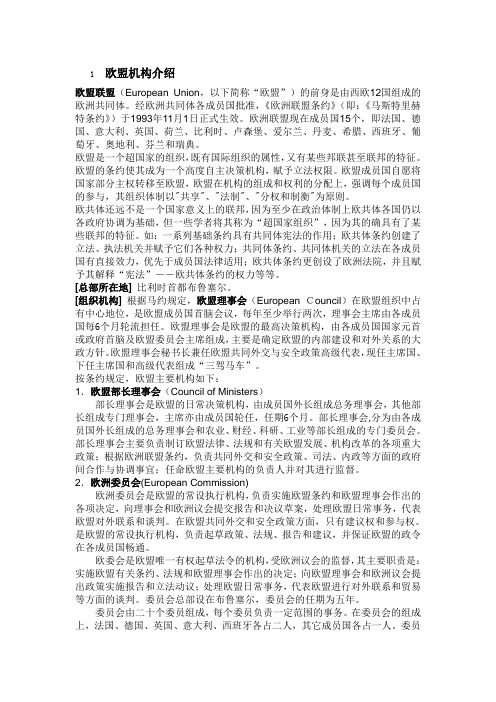
欧盟机构介绍欧盟联盟(European Union,以下简称“欧盟”)的前身是由西欧12国组成的欧洲共同体。
经欧洲共同体各成员国批准,《欧洲联盟条约》(即:《马斯特里赫特条约》)于1993年11月1日正式生效。
欧洲联盟现在成员国15个,即法国、德国、意大利、英国、荷兰、比利时、卢森堡、爱尔兰、丹麦、希腊、西班牙、葡萄牙、奥地利、芬兰和瑞典。
欧盟是一个超国家的组织,既有国际组织的属性,又有某些邦联甚至联邦的特征。
欧盟的条约使其成为一个高度自主决策机构,赋予立法权限。
欧盟成员国自愿将国家部分主权转移至欧盟,欧盟在机构的组成和权利的分配上,强调每个成员国的参与,其组织体制以"共享"、"法制"、"分权和制衡"为原则。
欧共体还远不是一个国家意义上的联邦,因为至少在政治体制上欧共体各国仍以各政府协调为基础,但一些学者将其称为“超国家组织”,因为其的确具有了某些联邦的特征。
如:一系列基础条约具有共同体宪法的作用;欧共体条约创建了立法、执法机关并赋予它们各种权力;共同体条约、共同体机关的立法在各成员国有直接效力,优先于成员国法律适用;欧共体条约更创设了欧洲法院,并且赋予其解释“宪法”――欧共体条约的权力等等。
[总部所在地]比利时首都布鲁塞尔。
[组织机构]根据马约规定,欧盟理事会(European Council)在欧盟组织中占有中心地位,是欧盟成员国首脑会议,每年至少举行两次,理事会主席由各成员国每6个月轮流担任。
欧盟理事会是欧盟的最高决策机构,由各成员国国家元首或政府首脑及欧盟委员会主席组成,主要是确定欧盟的内部建设和对外关系的大政方针。
欧盟理事会秘书长兼任欧盟共同外交与安全政策高级代表,现任主席国、下任主席国和高级代表组成“三驾马车”。
按条约规定,欧盟主要机构如下:1.欧盟部长理事会(Council of Ministers)部长理事会是欧盟的日常决策机构,由成员国外长组成总务理事会,其他部长组成专门理事会,主席亦由成员国轮任,任期6个月。
欧盟的社会福利与社会保障制度

欧盟的社会福利与社会保障制度社会福利和社会保障制度是欧盟成员国在保障公民权益和促进社会公平方面所实施的一项重要政策。
本文将探讨欧盟的社会福利与社会保障制度的主要特点和发展情况。
一、社会福利制度社会福利是指国家或政府为了保障公民基本权益、提高社会福利水平而实施的一系列政策和措施。
在欧盟的社会福利制度中,主要包括以下几个方面:1. 医疗保障:欧盟成员国普遍实行公共医疗保障制度,通过全民医保、医疗补助等方式保障公民的医疗需求。
这些医疗保障制度通常由政府提供基本医疗服务,并设立医保基金用于支付医疗费用。
2. 养老保障:欧盟成员国普遍实行基本养老保险制度,为年老无能劳动能力的公民提供基本的生活保障。
养老保障通常涉及退休金制度和养老金制度,以确保公民在老年时能够拥有足够的经济来源。
3. 失业保障:欧盟成员国致力于提供完善的失业保障制度,为失去工作的公民提供一定期限内的经济补偿和职业转换援助。
这些失业保障制度旨在减轻失业人员的经济压力,并帮助他们尽快重新就业。
4. 住房保障:欧盟成员国普遍实行住房保障制度,为居住在困难住房条件下的公民提供适当的住房保障。
这些住房保障制度包括公共住房分配、租金补贴等政策,旨在改善住房条件,提高居民生活水平。
二、社会保障制度社会保障制度是指国家或政府为了保障公民社会权益,提供社会风险防范和风险分担的一种制度安排。
在欧盟的社会保障制度中,主要包括以下几个方面:1. 基本工资保障:欧盟成员国普遍实行最低工资制度,确保所有工人都能获得一定的工资水平,以维持基本的生活需求。
这种基本工资保障旨在减少收入差距,提高低收入人群的生活水平。
2. 健康保险:欧盟成员国普遍实行公共健康保险制度,通过税收或社会保险费用来筹措资金,为公民提供医疗保健服务。
这些健康保险制度旨在确保每个公民都能够获得质量和可及性兼备的医疗服务。
3. 工伤保险:欧盟成员国普遍设立工伤保险制度,为工作期间发生事故或职业疾病的工人提供经济补偿和医疗救助。
- 1、下载文档前请自行甄别文档内容的完整性,平台不提供额外的编辑、内容补充、找答案等附加服务。
- 2、"仅部分预览"的文档,不可在线预览部分如存在完整性等问题,可反馈申请退款(可完整预览的文档不适用该条件!)。
- 3、如文档侵犯您的权益,请联系客服反馈,我们会尽快为您处理(人工客服工作时间:9:00-18:30)。
Nations have differing priorities re:
Fra bibliotekSocial aspect in Treaty of Rome
economic and social progress
low priority not specific
Developments in future, particularly single market
1971 reforms
financing from State levies to EU’s ‘own resources’ 2 broad objectives
facilitate employment adjustment from EU policies help overcome structural problems experienced by regions / groups, eg young job seekers
paid holidays living & working conditions vocational training established ESF (1960)
ESF
Initially limited
financial support to temporarily unemployed migrant workers localised retraining
Adopt raft of social policies Raises cost of employing workers by ‘T’ Result:lower wage (W1) & employment (L1) Important: wage incl wage & non-wage costs
(2) 1950s-1970s
Little progress beyond TOR TOR, despite deficiencies did seek to establish
freedom of movement for workers freedom of establishment equal pay rights for migrant workers
greater burden of (T) falls on workers
Open economy
vocational training more important
Greater activity Several ‘minor’ developments SEA - main impetus for change
(3) 1980s: Social dimension of the SEM
Open economy
Now, consider open economy More elastic demand (now D2)
greater integration in goods mkt greater competition between workers
Wage falls below W1 if social policies, (non-wage )cost = T
Closed economy
Real wage
D S
w
L
Labour
Closed economy
Real wage
D1 T D S
w w1
L1 L
Labour
Non-wage benefits include
Part of wage taken as benefits rather than take home pay Limit working hours (eg Working Time Directive, French 35 hr week) Maternity, paternity & sick leave Pension benefits Holidays TUPE
Social policy: Counterbalance to SEM
Integral part of econ policy Strengthens social cohesion
Economic integration creates winners and losers Willingness to undertake economic integration depends on the winners readiness to compensate the losers
Argued ‘safety net’ required for broad political support Argued prerequisite for economic integration
Social policy & productivity
EU founders believed full harmonisation of social policies not necessary component of integration
the division of wage & non-wage costs (ie: social policies) have limited impact
Assume
initially no social policy & closed economy wage W, employment level L
EU Social Policy
ref: social policy Mar 09
(1) Introduction
Broad definition in EU compared to UK
Employment & living conditions (welfare) labour markets social security leisure & other social aspects
